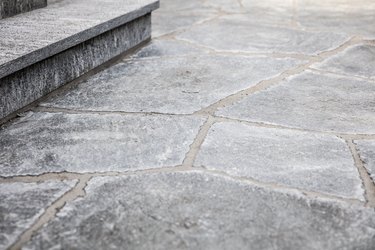
Options abound when laying a flagstone walkway, from choices of stone to the method used to finish it off. These choices affect the lifetime of the walkway , as well as the wear and tear it can develop. Become familiar with grout options to choose the method of laying that will work best.
Two Types of Grout
Video of the Day
While the terms "cement," "concrete," and "mortar" are often used interchangeably, these are not all the same thing. Cement is an ingredient in both concrete and mortar, but it is not the finished material. Concrete is a mixture of cement, water and aggregates such as sand or stone. Mortar is a type of concrete made from cement, water, sand, and usually hydrated lime. It's meant especially for setting masonry and is sticky, so as to bind the masonry together. When considering a flagstone walkway, two basic options are available as far as grouting: mortar or a dry laid method.
Video of the Day
Make and Use Mortar
It's simple to make mortar by mixing Portland cement, sand and water. While hydrated lime is not a necessary ingredient, it makes the mortar more elastic and workable. Hydrated lime also keeps the sand and cement from separating, makes the mortar less prone to shrinkage and makes it more waterproof.
The basic recipe for this sort of mortar is 9 parts sand, 2 parts cement, and 1 part hydrated lime. Mix these together well before adding the water. Add the water slowly until it reaches a texture that stands up when shaped. Don't mix more mortar than you can use in just a few hours as it begins to stiffen and become unusable.
Use a Dry-Laid Method
In this method, there is no concrete poured beneath the walkway. The pavers are laid on a bed of tamped sand, which is usually situated over a layer of gravel. Fine masonry sand is then swept into the joints or pushed in with a trowel. The sand cushions and levels to make up for the minor irregularities in the gravel or lower layer of sand.
This kind of construction creates a walkway that is stable and durable even in climates subject to frost, which might crack mortar. It also allows for replacing damaged paving materials more easily, or removing sections of the walkway that require access to buried water pipes or utility lines. However, the sand between the stones washes away over time, requiring replacement. Another factor to consider is that, in areas of shifting ground, walkways made with the dry laid method are more likely to heave up than mortared walkways.